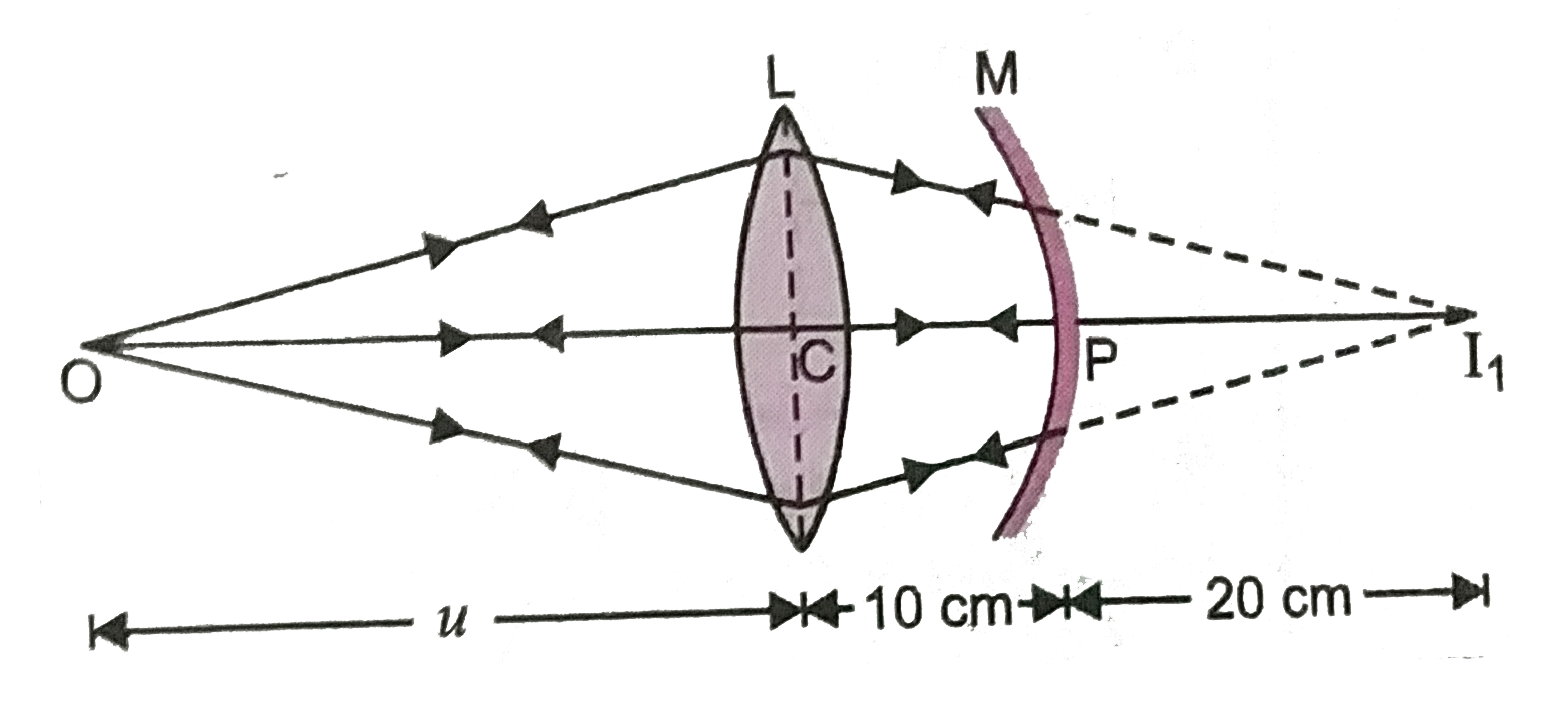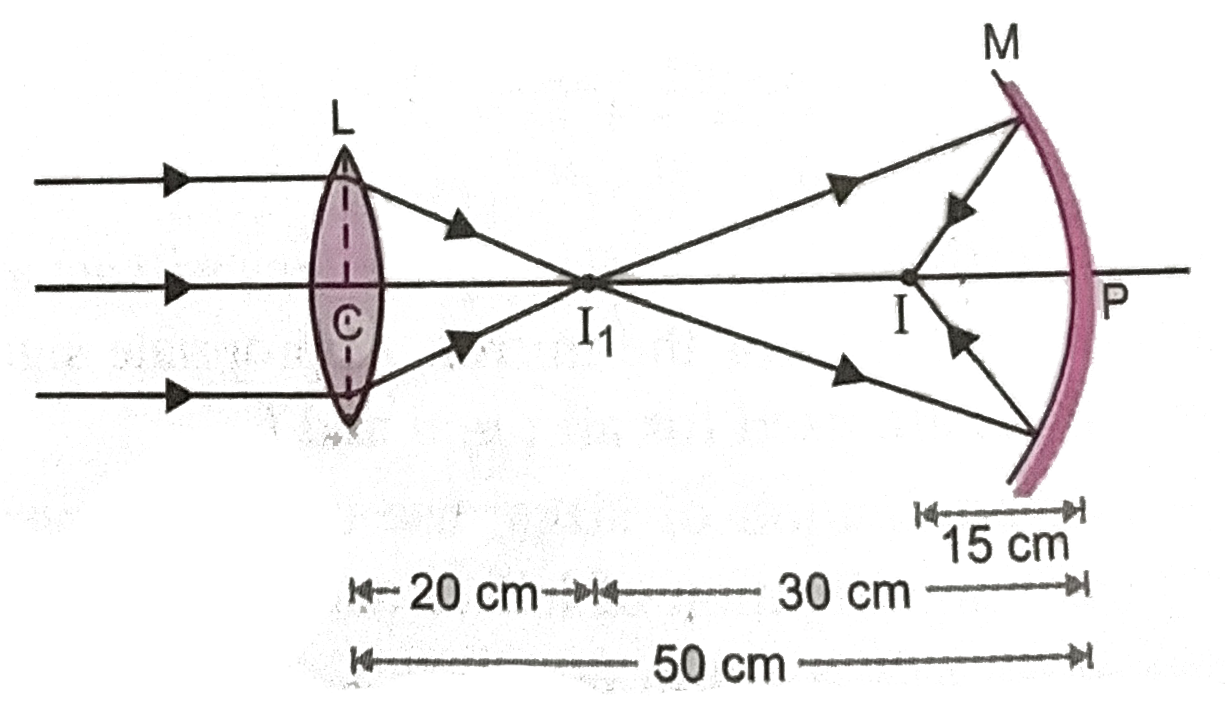A convex lens of focal length 15cm, and a concave mirror of radius of curvature 20cm are placed co-axially 10cm apart. An object is placed in front of convex lens so that there is no parallax between the object and its image formed by the combination. Find the position of the object.
The correct Answer is:At 30cm from lens
The given set up is shown in Fig. Here, focal length of lens, f=15cm , radius of curvature of concave mirror, R=20cm and CP=10cm. Let the object be at O, where CO=u. As there is no parallax between the object and its image formed by the combination, therefore, final image must be at O itself. For this to happens, rays refracted from convex lens L must tens to meet at I1, the centre of curvature of concave mirror. These rays would fall normally on concave mirror and retrace their path on reflection.

∴PI1=R=20cm.
For the lens,
v=CI1=CP+PI1=10+20=30cm.
From 1v−1u=1f
−1u=1f−1v=115−130=130
∴u=−30cm, i.e., CO=30cm
i.e., object must be at 30cm in front of convex lens.
Topper's Solved these Questions
- BOOK - PRADEEPCHAPTER - OPTICSEXERCISE - Problems for practice4videos
OPTICS
- BOOK - PRADEEPCHAPTER - OPTICSEXERCISE - Comprehension 11videos
OPTICS
- BOOK - PRADEEPCHAPTER - OPTICSEXERCISE - Value based questions3videos
OPTICS
- BOOK - PRADEEPCHAPTER - MAGNETIC EFFECT OF CURRENT AND MAGNETISMEXERCISE - Competition Focus (Multiple Choice Questions)2videos
MAGNETIC EFFECT OF CURRENT AND MAGNETISM
Similar Questions
A convex lens of focal length 20cm is placed 10cm in front of a convex mirror or radius of curvature 15cm. Where should a point object be placed in front of the lens so that it images on to itself?
View SolutionA convex lens of focal length 20cm is placed co-axially with a convex mirrir of radius of curvature 20cm. The two are kept 15cm apart from eachother. A point object is placed 60cm in front of the convex lens. Find the position of the image formed by the combination.
View Solution
Knowledge Check
- Question 1 - Select One
A convex lens of focal length 20 cm and a concave lens of focal length 10 cm are placed 20 cm apart. In between them an object placed at distance x from the convex lens.
What is the value of x (in cm ) so that images from by both the lenses coincides ?A20(√3−1) and 1√3B10(√3−1)C20√3Dnone of these
A convex lens of focal length 20cm is placed coaxilly with a convex mirror of radius of curvature 20 cm. The two are kept 15 cm apart. A point object is placed 40 cm in front of the convex lens. Find the position of the image formed by this combination. Draw the ray diagram showing the image formation.
View SolutionA convex lens, of focal length 25 cm, and a concave mirror, of radius of curvature 20 cm. are placed co-axially 4 cm aprat from each other. An incident beam, parallel to the principal axis, is incident on the convex lens. Find the position and nature of the image formed by this combination.
View SolutionA convex lens of focal length 20cm and a convex mirror of focal length 10cm are placed co-axially 50cm apart from each other. An incident beam parallel to its principal axis is incideent on the convex lens. Locate the position of final image formed due to the combination.
View SolutionA concave lens of focal length 20 cm is placed 15 cm in front of a concave mirror of radius of curvature 26 cm and further 10 cm away from the lens is placed an object. The principal axis of the lens and the mirror are coincident and the object is on the axis Find the position and nature of the image.
View SolutionA small object is so placed in front of a convex lens of 5cm focal length that a virtual image is formed at a distance of 25 cm. Find the magnification.
View SolutionA convex lens of focal length 20cm and a convex mirror of focal length 10cm are placed co-axially 50cm apart from each other. An incident on the convex lens. Locate the position of final image formed due to the combination.
 (NCERT Solved Example)View Solution
(NCERT Solved Example)View SolutionA convex lens of focal length 30cm and a concave lens of focal length 60cm are placed in combination. If an object is placed 40cm away from the combination, find the position of the image.
View Solution

